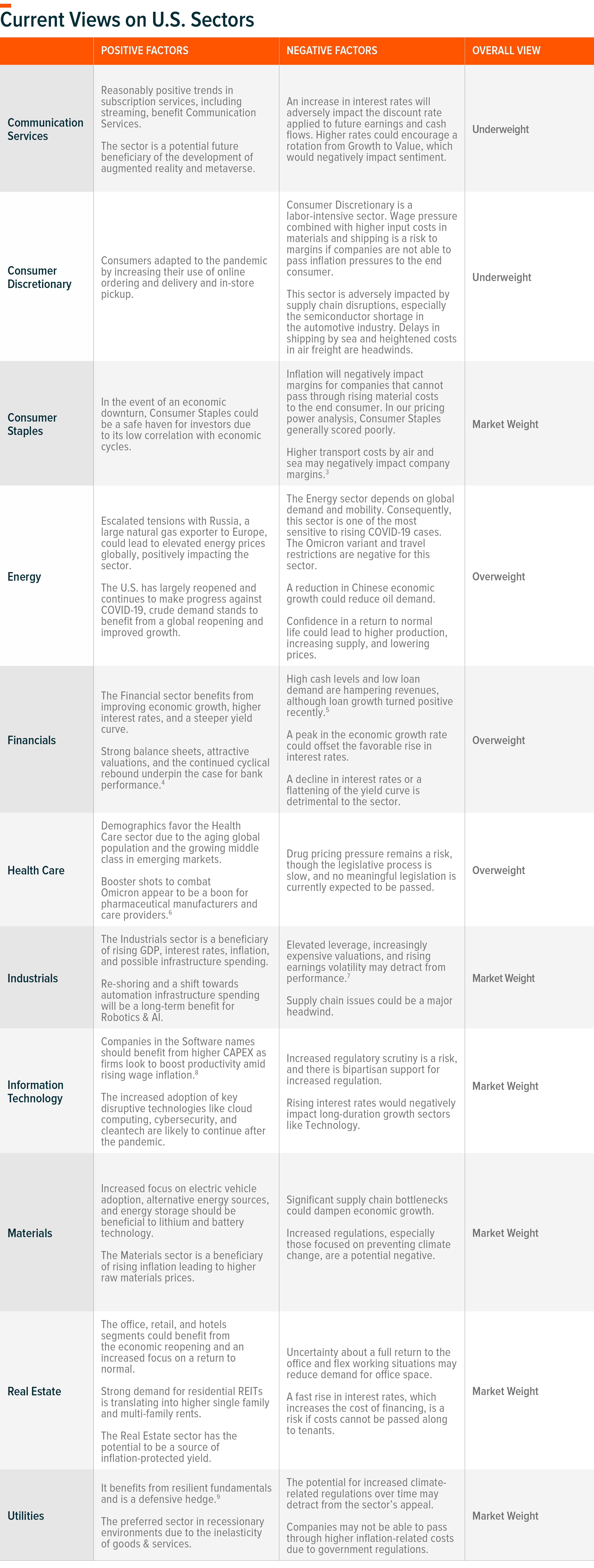Earnings in Q2 were strong, but rising labor costs and lingering supply chain issues were big topics of conversation on earnings calls. These inflation indicators are two major reasons why the market consensus currently expects earnings per share (EPS) growth in the S&P 500 to slow from 27% in Q2 to 17% in 3Q and 22% in 4Q on a 2-year basis.1 One of the central questions for the market right now is whether the recent acceleration in inflation is transitory or not. If it is something else, how will the Federal Reserve (Fed) proceed?
By sector, companies in the Staples and Materials sectors had the most inflation mentions during Q2 earnings calls. Industrials and Consumer Discretionary, two of the most labor-intensive sectors in the S&P 500, accounted for the most labor inflation mentions. Industrials firms spoke about supply chain inflation the most, while Materials firms referenced inflation in raw material and transportation the most. Looking ahead, the latest consideration for Industrials and Materials is the passage of the $1.2 trillion bipartisan infrastructure bill, as both sectors should be direct beneficiaries over the next decade.
Wage pressure remains a tailwind for earnings, with prices and unit volume growth still outpacing wage costs. However, the dynamics could change if economic growth slows, or companies can’t pass through costs. The Consumer Discretionary sector is at most risk from rising wage inflation.
Lingering supply-side constraints continue to hover over the U.S. recovery. The Port of Los Angeles has set a new record for backlogged container ships, with 44 vessels waiting to unload their goods. Hurricane Ida may further stretch supply chains. There will be inevitable disruption owing to the need for building materials which are already in short supply, as well as complications for energy companies whose production, refining and transport infrastructure was directly in the path of the storm. Roughly 4.4 million barrels of crude refining and 6.5 million tons of ethylene production annual capacity is located within the storm’s path.2
Should the supply side languish further, and the COVID Delta variant increasingly affect consumer behaviors, the risk is that consumer spending slows while precautionary savings rise. This may already be playing out, as retail sales fell 1.1% month-over-month (m/m) in July while the savings rate ticked up slightly.3 Bank of America aggregated credit card data shows that consumers pulled back on their spending during the month, especially for leisure services.4 August’s Consumer Sentiment rating was the weakest in over a decade as expectations slumped and personal financial prospects worsened. Delta is clearly weighing on the minds of consumers who remember their quarantine lifestyles all too well.
Despite weakening consumption data, the minutes from July’s Federal Open Market Committee’s (FOMC) meeting indicated that a majority of members want to start tapering the Fed’s monthly $120 billion bond purchases this year. Powell indicated at Jackson Hole that the Fed could begin slowing down asset purchases but is not in a rush to raise interest rates owing to stubborn employment data.
Powell said tapering should not be interpreted as a direct precursor to rate hikes. The plan remains to hold the federal funds rate “until the economy reaches conditions consistent with maximum employment, and inflation has reached 2% and is on track to moderately exceed 2% for some time.” On that front, Powell said the economy has much more to prove. The markets jeered the guidance, but we feel Powell is playing with fire and is at risk of reinforcing inflation.5
Sector Views
As we distill down our sector calls for August, the main points we incorporate concern rising rate exposure, consequences of lasting inflation, and valuation risks amid a quickly nearing stimulatory event consisting of trillions in additional infrastructure spending.

 Global X ETF Model Portfolio Team
Global X ETF Model Portfolio Team